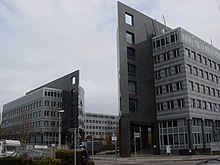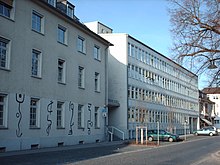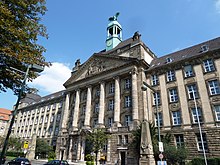Regional Council
Regional councils or district governments in Germany national safety authorities responsible for the area of government district as an interface between state- government on one hand and district administration offices , cities and municipalities to act on the other.
structure
Intern
In view of the division into line ministries when dealing with problems (sectoralization), the regional councils have the important coordination and bundling function: State action from a single source. The employees in regional councils manage a wide variety of public tasks. This also includes the distribution of public funds, both for regular tasks and for funding measures. In addition, regional councils have supervisory, control and approval functions. This is to ensure that the regional councils ensure that the political will can be enforced unimpaired.

Regional councils are from a provincial government headed. The organizational structure is divided into departments and units . The departments are headed by department heads. The example of Baden-Württemberg shows the following breakdown of the regional councils into individual departments:
- Control and administration
- Economy, spatial planning, construction, monument and health care
- Agriculture, Rural, Veterinary and Food
- Roads and traffic
- environment
- State Police Directorate
- school and education
- Forest management and state forest management
- Possibly. individual regional offices or functions such as B. the state office for road technology, measurement and calibration, the state monument office, the state health or the state mining authority.
If the tasks of the intermediate authorities are shifted to lower instances, it must be ensured according to the principle of granting that the local area of responsibility of the general authorities and the special authorities as well as the various special authorities are territorially congruent and that these different authorities are responsible for one and the same geographical area (" administrative geographic congruence ”).
In the federal states



There are regional councils (RP) in four federal states. They have different names in Bavaria and North Rhine-Westphalia .
Saxony , Saxony-Anhalt and Thuringia also have authorities that act as intermediaries between the ministry and city and district levels; legally, however, they have the rank of a higher state authority . As is typical for higher regional authorities, these authorities are responsible for the entire country. In Thuringia the authority is called the Thuringian State Administration Office , in Saxony it is the State Directorate Saxony and in Saxony-Anhalt the State Administration Office Saxony-Anhalt .
The other federal states have an administrative structure without an intermediate authority. Brandenburg , Lower Saxony , Rhineland-Palatinate and Schleswig-Holstein follow the concept of special authorities with functional responsibilities. Small states like Mecklenburg-Western Pomerania and Saarland get by with a two-tier administrative structure.
criticism

Regional councils and state middle authorities themselves have often been discussed in connection with administrative reforms as potential for job cuts or job cuts in recent decades . For example, you operate in many federal states and the like. a. also as an objection authority , while objection proceedings in other federal states, such as B. in the Free State of Bavaria, were abolished. The administrative reform in Lower Saxony, however, has also revealed clear disadvantages in the opinion of administrative science due to the elimination of the regional councils: many decentralized branch offices without functional bundling.
Political scientist Jörg Bogumil sees the tripartite administrative structure with central authorities such as the regional councils as the most efficient solution for an administrative structure in the federal states, especially for large, densely populated territorial states such as B. Baden-Württemberg, Hesse or Bavaria.
advantages

The advantages of regional councils in their practical work today are:
- In comparison to ministries, which focus on conceptual and political work, regional councils are “close enough” to the citizens as well as to the customers and partners of the administration, but at the same time “far enough away” to be able to make independent decisions from an objective distance.
- They combine the specialist departments, which are subdivided at the ministerial level, into one authority, thereby realizing the principle of unity of administration.
Regional councils are proving to be beneficial in coordinating or managing cross-district projects.
- In contrast to the rural districts , regional councils have an overview of the entire area of a government district and thus a much larger territory. Funding needs can thus be better identified for a very large area and funding procedures implemented more successfully.
- Due to the size of a bundling authority, regional councils are in a position, compared to other authorities, to keep a pool of specialists and experts available for an immense variety of tasks that are performed by the public administration.
- The district presidents play a special role: on the one hand, they are representatives of the government in the area, with the appropriate authority that is already reflected in their official title. On the other hand, they appear to the government as representatives of their region, with their knowledge of local conditions, problems and interests. This is the advantage over the functional construction, as it is e.g. B. has been installed in Rhineland-Palatinate.
Regional councils can, depending on the federal state, pursue up to 3000 different tasks in a government district, which require ever greater specialist knowledge. Administrative districts can sometimes be the size of federal states. Subordinate, "smaller" administrative authorities such as B. In comparison, district offices would structurally not be able to employ the multitude of specialists for the same space and areas as regional councils with the same efficiency and the same use of resources.
- The bundling of the large number of specialists “under one roof” also means that B. can better network with large approval procedures and planning. This means that the administration comes to administrative decisions much faster and more efficiently than in an administrative landscape with fragmented special authorities (cf. Bogumil, Stuttgarter Nachrichten of December 13, 2012, p. 6).
The administrative structural reform in Baden-Wuerttemberg on January 1, 2005 proves to be particularly advantageous in this respect, as it consciously decided to maintain a 3-part administrative structure and at the same time to dissolve numerous special authorities, with the aim of providing the citizen as an administrative partner, depending on the task of offering either district offices or regional councils. The main objective of the reform of a citizen-friendly, efficient administration under the motto:
- A house
- An area
- One authority
- A decision
can be achieved. The clear structures and responsibilities as well as the bundling created by them lead to greater administrative efficiency, clarity and acceptance of administrative decisions and structures by companies, associations and citizens. Due to the hierarchical structure, differences of interest can already be decided within the regional council, which relieves the government level.
Political perspective
Provided that regional councils are not assessed across the board against the background of their size and number of employees, but rather their administrative advantages are identified over a large area and the efficiency aspects achieved are considered, from the perspective of a state government they provide another advantage compared to alternative administrative structure models:
Due to their independence from local authorities and local parliaments, regional councils can enforce the parliamentary will and the will of the government in the area. In this way, they actually represent the extended arm of the state parliament and the state government in a federal state.
See also
literature
- Choice in: Siegfried Frech, Reinhold Weber , Handbuch der Kommunalpolitik , p. 61 ff.
- Hans-Georg Wehling : History, tasks and importance of the regional councils , in: Festschrift für Max Gögler , 1996
- stuttgarter-zeitung.de February 24, 2012: Close to problems, but far from interests
Web links
Individual evidence
- ↑ Election in: Frech / Weber: Handbuch der Kommunalpolitik , p. 61 ff.
- ↑ Jörg Bogumil and Steffen Kottmann (2006): Administrative structural reform - the abolition of the district governments in Lower Saxony ( online (pdf) )
- ↑ Jörg Bogumil: "Personell on the stand from 1968", Stuttgarter Nachrichten of December 13, 2012, p. 6 ( online (pdf) )


